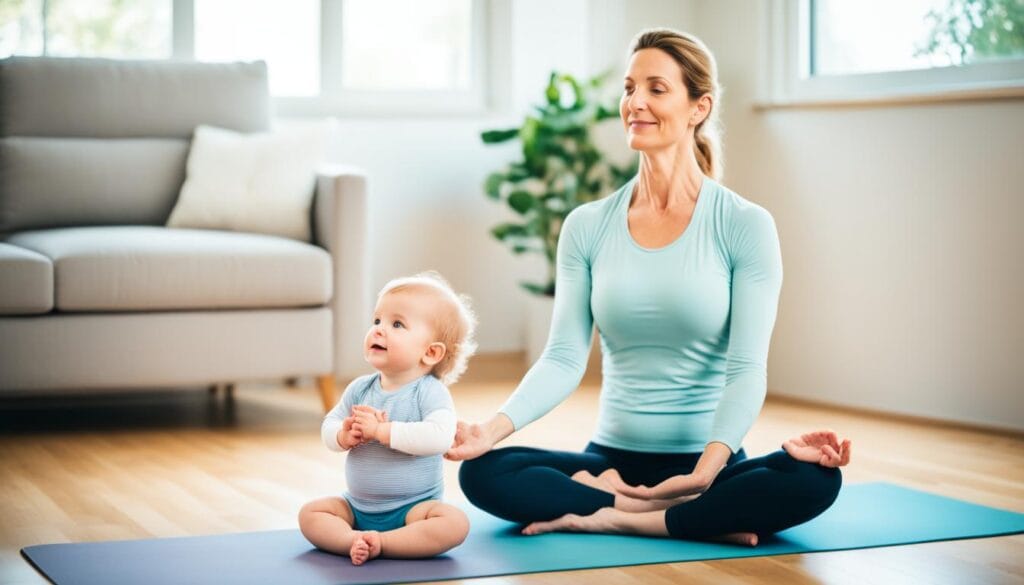
As a new mom, finding time for self-care can feel tough. But, a gentle postpartum yoga practice could help. It can help you regain strength, improve your mood, and connect with your body again. In this guide, I’ll share my personal experience and expert advice on postpartum yoga for beginners like you.
Have you ever thought about how postpartum yoga is different from prenatal yoga? Or how to safely add yoga to your postpartum recovery? If so, you’re in the right spot.
Key Takeaways
- Postpartum yoga is a gentle, restorative practice that can aid in your postpartum recovery and reconnection with your body.
- Gentle yoga routines and poses can help restore energy, relieve stress, and promote relaxation for new moms.
- Incorporating postpartum yoga into your routine can support your physical and mental well-being during this transformative time.
- Proper modifications and the use of props can make postpartum yoga accessible and comfortable for beginners.
- Postpartum yoga differs from prenatal yoga, with a focus on restoring and strengthening the body after childbirth.
Understanding Postpartum Yoga
Postpartum yoga is a special practice for new moms after childbirth. It’s different from regular yoga. It uses gentle movements to help with postpartum issues, increase energy, and improve well-being.
What is Postpartum Yoga?
Postpartum yoga is a gentle yoga for new moms. It includes poses, breathing exercises, and mindfulness. These are made for the postpartum body’s needs. The aim is to help moms get strong, flexible, and balanced. It also supports their emotional and mental health during this big change.
Benefits of Postpartum Yoga for New Moms
Starting with postpartum yoga for beginners has many benefits for new moms, such as:
- Improved physical recovery and reduced postpartum discomfort
- Enhanced postpartum fitness and muscle tone
- Increased energy levels and reduced fatigue
- Better sleep quality and stress management
- Improved mood and emotional well-being
- Strengthened pelvic floor and core muscles
- Facilitated postpartum recovery exercises and healing
- Promotion of yoga for postpartum healing
Adding yoga for new moms to their routine helps new moms build strength, regain energy, and find calm. It’s a great way to connect with themselves during this big change.
Preparing for Your Postpartum Yoga Journey
Starting your postpartum yoga practice is a big step. It’s important to prepare safely and successfully. Let’s look at what you should consider before you begin.
First, talk to your healthcare provider. They can tell you when it’s safe to start postpartum exercises. They’ll also suggest any changes you might need because of how you delivered or how you’re recovering. Always listen to your body and don’t rush back too quickly.
Think about how much energy you have. Being a new mom can be very tiring, both physically and emotionally. Start with easy, calming postnatal yoga exercises. Then, slowly increase your strength and stamina as you get stronger.
Remember, prenatal yoga and postpartum yoga are different. Both help the body during big changes, but postpartum yoga focuses on the special needs of new moms. It helps with core strength and dealing with pelvic floor issues.
“Postpartum yoga is a gentle, nurturing practice that can help new moms reconnect with their bodies and find a sense of calm amidst the chaos of new motherhood.”
Preparing for your postpartum yoga journey helps you have a great experience. Remember, getting back to normal takes time. Be patient, kind to yourself, and celebrate every small victory.
Essential Postpartum Yoga Poses
As a new mom, gentle postpartum yoga can change your life. These poses ease discomfort, help you relax, and support your recovery. Let’s look at some key postpartum yoga poses for your journey.
Gentle Stretches for Postpartum Recovery
Gentle stretches are key in postpartum yoga. They help with tightness after childbirth. Here are some easy yet powerful poses:
- Cat-Cow Pose: Arch your back on the inhale and round it on the exhale. This eases spine tension.
- Child’s Pose: This pose lets you rest and release, offering a sense of grounding.
- Legs-up-the-Wall Pose: Elevating your legs reduces swelling and boosts circulation.
Restorative Poses for Relaxation
Postpartum yoga also includes restorative poses for deep relaxation and stress relief. Add these calming poses to your routine:
- Supported Backbend: Use props to gently open your chest and heart, promoting calm.
- Reclined Bound Angle Pose: This pose helps you relax your body and focus on your breath.
- Savasana (Corpse Pose): The ultimate pose for rest and restoration, inviting you to surrender.
Your postpartum yoga should fit your needs and comfort. Be patient, listen to your body, and let these poses guide you to a balanced state.
“Postpartum yoga is a gentle, therapeutic practice that can help you reconnect with your body and mind during this transformative time.”
Postpartum Yoga for Beginners
Starting yoga as a new mom can feel both exciting and scary. But, postpartum yoga for beginners is made to be easy, healing, and open to everyone. I’ll help you learn the basics of yoga for new moms. We’ll create a gentle yoga routine that meets your postpartum fitness goals.
Postpartum yoga is great because it can be adjusted to fit your body and needs. If you’re recovering from a C-section, have pelvic floor issues, or want to get stronger and more flexible, there are many gentle yoga poses and changes you can do.
Starting Your Postpartum Yoga Practice
To begin a successful postpartum yoga for beginners practice, start slow and pay attention to your body. Here are some tips to help you start:
- Start with 10-15 minutes of easy stretching and breathing, then slowly add more time as you get more comfortable.
- Focus on poses that work on the core, hips, and pelvic floor, like child’s pose, gentle backbends, and cat/cow.
- Use props like blocks, straps, or blankets for extra support and balance.
- Breathe deeply and move carefully, listening to what your body needs right now.
Postpartum fitness is a journey, not a competition. Be kind to yourself, celebrate your achievements, and get help from a qualified yoga teacher or doctor if you have worries.

“Postpartum yoga has been an invaluable part of my recovery. The gentle movements and breath work have helped me regain strength, flexibility, and a sense of calm during this incredible time.” – Emily, new mom
Modifying Poses for Your Comfort
As a new mom, listen to your body and adjust your postpartum yoga as needed. Your body is healing, and it’s key to respect its needs. By changing yoga poses, you can keep a safe and effective routine that helps your postpartum recovery.
Using Props for Support
Adding props to your postpartum yoga can really help. Tools like blocks, straps, and blankets help with alignment, deepening stretches, and stability in poses. Don’t be shy about using these tools to make your practice easier and more accessible.
- Blocks can be placed under your hands or feet to reduce the range of motion and provide extra support.
- Straps can be used to assist in stretching tight muscles or to help you hold poses for longer periods.
- Blankets can be folded and placed under your knees, hips, or lower back to cushion sensitive areas.
Try out different props and see what works best for you and your postpartum yoga. Remember, using props is a sign of taking care of yourself, not a sign of weakness.
| Prop | Benefit |
|---|---|
| Yoga Blocks | Provides support and stability for your hands and feet, reducing the intensity of poses |
| Yoga Straps | Assists in stretching tight muscles and holding poses for longer durations |
| Blankets | Cushions sensitive areas and supports your joints, promoting comfort and relaxation |
Your postpartum yoga journey is special, and using modifications and props shows you care about your body’s needs. With some trial and error, you can make a practice that helps you heal, restore, and grow during this important time.
Postpartum Yoga Sequences for New Moms
As a new mom, finding the right postpartum yoga sequences can change your recovery journey. Gentle yoga routines can boost your energy, promote relaxation, and support your well-being. Let’s explore a sample morning yoga routine for postpartum moms.
Morning Routine for Energy
Start your day with this caring yoga for new moms sequence. It helps you feel grounded, centered, and energized. This 20-minute flow mixes gentle yoga routines and breathwork to wake up your body and mind.
- Begin in a comfy seated position, taking a few deep, cleansing breaths.
- Gently roll your shoulders back and down, releasing any tension in your neck and upper back.
- Move to a tabletop position, and slowly arch and round your spine, moving with your breath.
- Do a few rounds of cat-cow poses, letting your body move easily.
- From tabletop, extend one leg back, then the other, coming into a gentle downward-facing dog.
- Hold for a few breaths, then step or jump your feet toward your hands, coming into a forward fold.
- Slowly roll up to standing, taking a moment to notice how you feel.
- End your practice with a few moments of stillness, honoring the big changes your body has gone through.
The key to a great postpartum fitness routine is listening to your body and honoring its unique needs. Start small, celebrate your progress, and don’t hesitate to seek advice from a qualified yoga instructor or healthcare professional.

Incorporating Breath Work
Postpartum yoga is more than just the poses. It’s also about the breath. Breath work is key in this practice. It helps manage stress, ease anxiety, and connect your mind and body. For new moms, adding breath work to your yoga routine is great for your wellbeing.
Breath work in postpartum yoga calms the nervous system. Deep, rhythmic breathing triggers the “rest and digest” response. This is great for reducing overwhelm, irritability, and postpartum anxiety that new moms often feel.
Besides reducing stress, breath work also boosts your mind-body awareness. By focusing on your breath, you tune into your body’s subtle sensations. This helps you understand your physical and emotional needs better. It’s very helpful as you adjust to being a new parent.
To add breath work to your postpartum yoga, start with simple techniques like diaphragmatic breathing or alternate nostril breathing. These exercises can be done anytime, during yoga or when you just need to pause. Try different breath work to see what works best for you and your postpartum needs.
“Breath is the bridge which connects life to consciousness, which unites your body to your thoughts. Breathe in, breathe out. Just focus on your breath until you feel centered and calm.”
Your postpartum yoga journey is personal. The breath work you choose should match your needs and likes. By using the breath, you can find deeper healing, self-care, and connection during this time.
Prenatal Yoga vs. Postpartum Yoga
As a new mom, it’s key to know the differences between prenatal and postpartum yoga. Both types support women’s health but in different ways during the postpartum phase.
Prenatal yoga is for expectant moms, helping them with pregnancy’s physical and emotional changes. It adjusts poses for the growing baby inside. Postpartum yoga focuses on new moms’ recovery and the needs of caring for a newborn.
| Prenatal Yoga | Postpartum Yoga |
|---|---|
| Focuses on pregnancy-related needs | Addresses postpartum recovery and the unique needs of new moms |
| Emphasizes poses that open the hips and pelvis | Incorporates gentle stretches and restorative poses to rebuild strength |
| Prepares the body for childbirth | Helps new moms regain physical and emotional well-being |
Knowing the differences between prenatal and postpartum yoga helps you pick the right practice for you. Postpartum yoga is great for restoring balance, reducing stress, and promoting overall wellness during this big change.
“Postpartum yoga is a gentle, nurturing practice that helps new moms reconnect with their bodies and find inner calm amidst the joys and challenges of motherhood.”
Addressing Common Postpartum Concerns
As a new mom, I know the postpartum period brings unique challenges. Luckily, postpartum yoga can help with healing from C-sections or perineal tears.
Healing from C-Section or Perineal Tears
Recovering from a C-section or perineal tears is delicate. Gentle postpartum yoga poses and postpartum yoga sequences can strengthen the core and improve posture. They also help with healing the pelvic floor.
Poses like modified planks and bridges are great for C-section scar tissue and diastasis recti. For perineal tears, restorative postpartum yoga poses are key. Child’s pose, butterfly, and supported squat help relax and strengthen the pelvic floor muscles.
Adding postpartum recovery exercises and yoga for postpartum healing to your routine can greatly improve your well-being. Always start slow, listen to your body, and check with your healthcare provider for a safe practice.
“Postpartum yoga can be a powerful tool in addressing the unique challenges of the postpartum period. By focusing on gentle, restorative poses, we can help the body heal and regain strength.”
Postnatal Exercises Beyond Yoga
Postpartum yoga is great for easing back into exercise, but there are other options too. Let’s look at different exercises that can help with your postpartum wellness.
Adding various exercises can help you get stronger, boost your heart health, and aid in recovery. Here are some alternatives for postnatal exercises, postpartum fitness, and postpartum recovery exercises.
Walking and Low-Impact Cardio
Walking is a simple yet effective exercise for new moms. It helps improve your stamina and heart health. You can also try swimming or cycling to keep moving without putting too much strain on your body.
Strength Training
Strength training can help you regain muscle tone and improve your body shape. Focus on exercises like squats, lunges, and rows. As you get stronger, you can increase the weight you lift.
Pelvic Floor Exercises
Strengthening your pelvic floor muscles is key for recovery after childbirth. Do Kegel exercises often to help with bladder control and support your core. A pelvic floor physical therapist can give you personalized advice on how to do these exercises.
| Postnatal Exercise | Benefits | Precautions |
|---|---|---|
| Walking | Improved cardiovascular fitness, gradual strengthening | Start with short, manageable distances and gradually increase |
| Strength Training | Muscle tone restoration, improved body composition | Avoid heavy weights or high-intensity exercises initially |
| Pelvic Floor Exercises | Bladder control, core support | Consult a pelvic floor specialist for personalized guidance |
Every postpartum recovery is different. It’s important to listen to your body and slowly add exercises that feel right for you. Talk to your doctor or a postpartum fitness expert to create a safe and effective plan.

Finding the Right Postpartum Yoga Class
As a new mom, finding the right postpartum yoga class can seem overwhelming. There are many options, so it’s important to pick one that meets your needs. I’ll help you find a class that helps you get strong, flexible, and balanced during this big change.
First, think about the instructor’s experience. Choose a class with a teacher trained in prenatal and postpartum yoga. They know how your body and mind are changing. They can give you the right moves and advice to keep you safe and effective.
Also, consider the class setting. Look for a place that feels welcoming and supportive for new moms. It should be quiet and have a community feel. This way, you can meet other moms going through the same things.
- Search for classes made just for postpartum yoga. They should have gentle poses that meet your needs.
- Think about the class size. Smaller classes let the teacher give you more personal help.
- Check if there are classes with childcare or ones that let you bring your baby.
Finding the right postpartum yoga class is key to a great experience. Your body and mind will appreciate the effort you put into taking care of yourself.
“Postpartum yoga is a gentle, nurturing practice that can help you reconnect with your body and restore a sense of balance during this precious time.”
Your postpartum yoga journey is special to you. Don’t be afraid to try different classes and teachers until you find the right one. With patience and effort, you’ll find the perfect class to support your recovery and help you shine as a new mom.
Postpartum Yoga for Beginners: Tips and Tricks
Starting your postpartum yoga journey can be both exciting and a bit scary. As a new mom, it’s key to be patient, kind to yourself, and realistic. Here are some tips and tricks to help you enjoy your postpartum yoga:
- Start Slow and Steady: Postpartum yoga is a slow process. Don’t rush into it. Start with easy poses and slowly increase your strength and endurance.
- Prioritize Self-Care: Postpartum yoga is not just about the physical. It’s also about taking care of your mind and heart. Make time for rest, relaxation, and things that make you happy.
- Utilize Props for Support: Use props like blocks, straps, and blankets to make poses easier and more comfortable. These are great for beginners.
- Listen to Your Body: Every postpartum recovery is different. Pay attention to what your body needs. If a pose doesn’t feel right, modify it or skip it.
- Celebrate Small Wins: Postpartum yoga isn’t about doing hard poses or being super flexible. Celebrate every step forward, no matter how small. Your body is amazing.
Remember, the most important thing in postpartum yoga is to be patient, flexible, and kind to yourself. By following these tips, you’ll find a fulfilling practice that helps your body, mind, and heart as a new mom.
Conclusion
As we wrap up our look at postpartum yoga for beginners, I urge you to trust your gut and listen to your body. The gentle routines and restorative poses we’ve talked about are key for new moms. They help restore strength, flexibility, and balance after having a baby.
Looking to improve your postpartum fitness, ease into postpartum recovery exercises, or just enjoy yoga for new moms? The basics of postpartum yoga for beginners can bring peace, self-care, and a closer bond with your body and mind. Pick the gentle yoga routines that feel right for you. Let this practice be a part of your yoga for postpartum healing journey.
There’s no one way to do postpartum yoga. Make your practice fit your needs. Try different styles and sequences until you find what suits you best. With time, kindness, and a readiness to try new things, you can discover the powerful effects of this practice. You’ll come out of the postpartum period feeling stronger, more stable, and more connected to yourself.
FAQ
What is postpartum yoga?
Postpartum yoga is a special practice for new moms after childbirth. It uses gentle movements to help with recovery, boost energy, and improve well-being.
What are the benefits of postpartum yoga for new moms?
It helps new moms with pelvic floor strength, reduces back and joint pain, and improves sleep. It also boosts energy and emotional well-being. Plus, it supports postpartum recovery and helps moms connect with their bodies again.
How do I prepare for my postpartum yoga journey?
Talk to your healthcare provider first. Think about your delivery and how you’re feeling. This prep ensures a safe and successful yoga practice.
What are some essential postpartum yoga poses?
Key poses include child’s pose and cat-cow for stretches. Also, try reclined bound angle and supported backbend for relaxation and comfort.
How do I modify poses for my comfort as a new mom?
Listen to your body and adjust your yoga as needed. Use blocks, straps, and blankets to support your poses and feel more comfortable.
Can postpartum yoga help with common postpartum concerns?
Yes, it helps with pelvic floor weakness, abdominal separation, and muscle imbalances. It aids healing, especially after C-sections or perineal tears.
How do I find the right postpartum yoga class?
Look for a class made for new moms and led by an experienced teacher. They should know the postpartum needs well.
What tips do you have for postpartum yoga beginners?
Start with realistic goals, focus on self-care, and listen to your body. Use props for support and modify poses when needed. Be patient and kind to yourself in your practice.

